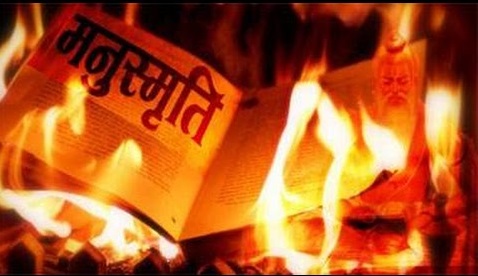
Dalit History Month – Manusmriti Dahan Din
“But a Shudra, whether bought or not bought (by the Brahmin) may be compelled to practice servitude, for that Shudra was created by the self-existent merely for the service of the Brahmin. Even if freed by his master, the Shudra is not released from servitude; for this (servitude) is innate in him; who then can take it from him?” – Manusmriti, 2 Chapter VIII, Verses 412-414”
Today in Dalit History, we remember Manusmriti Dahan Din. As a community of peoples marginalized through the religious structures of Caste: Adivasis, Dalits, and Bahujan, we celebrate one of the most radical forms of protest against Brahminism – burning the “Holy Text” – the Manusmriti – Manusmriti Dahan Din.
Babasaheb Ambedkar first publicly burned the Manusmriti on December 25th, 1927 during the Mahad Satyagraha. To him, this was an act of protest that cannot be confused for anything else. It is a direct naming of the foundational Hindu texts as the origin of Caste, and in burning the text, the protesters rejected both Hinduism and the inequality of the Caste system it birthed.
In order to avoid violent retaliation, the event had to be extremely carefully planned. Anticipating a bus boycott, Dr. Ambedkar arrived at the location by boat. The actual land for the Manusmriti burning was given by a Muslim ally in the anti-Caste movement, Mr. Fattekhan. The organizers brought all their own supplies of food, water or anything else could be conceivably needed so that nothing could be stopped. A pit was then built that was six inches deep and one and half foot square was dug in, and filled with sandalwood chips.
On its four corners, poles were erected, bearing banners announcing that this was a crematorium for the Manusmriti and that in burning it, we would both destroy Untouchability, and bury Brahmanism. After a powerful speech by Dr. Ambedkar, several volunteers then took 5 vows: 1. “I do not believe in the Chaturvarna (4-varna division of society upheld by texts).” 2. “I do not believe that Caste biologically makes people distinct from one another”. 3. “I believe that untouchability is an anathema and I will place all my efforts in the direction of destroying it.” 4. “I reject any Brahminical text-based restrictions on food and drink and culture.” 5. “I believe that untouchables must have equal rights to water, schools and all other public amenities.”
At this point at 9 p.m., the book of Manusmriti was burned and the flame kept alive by other Dalit leaders who fed it one at the time.
Following the protest, the Brahminical press was on edge. Babasaheb was called “Bheema Asura” ( “demon race” in Hindu texts) by many “upper”- Caste Hindus. For those who enquired, what is achieved for the oppressed Castes by burning it, he replied, “What was achieved by Mr. Gandhi by burning foreign clothes? This is the same for us.”
We continue this tradition every year on Manusmriti Dahan Din, in protest, when we burn the words that chain us. Jai Bhim! Onward!
From – Dalit History Month Collective




Unite and agitate